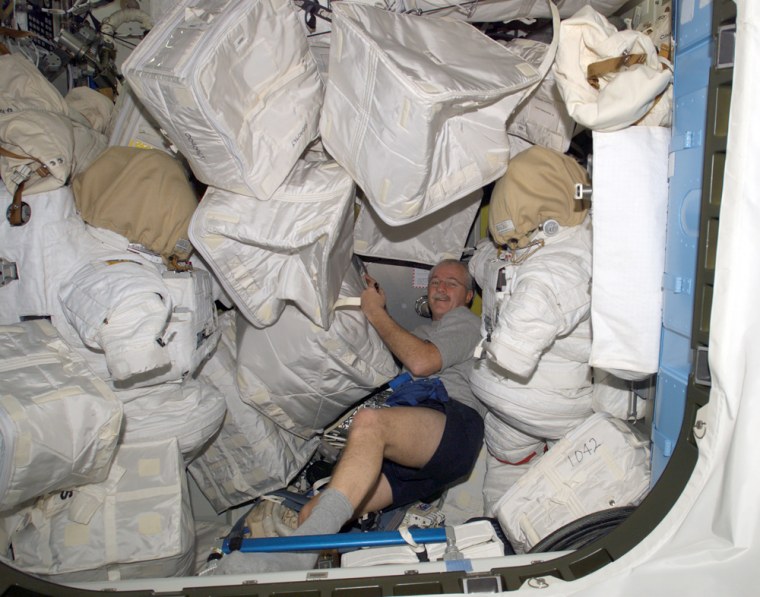Instead of flying high above Earth this week, NASA’s shuttle Discovery is crawling down from its launch pad to switch external tanks, a move that has delayed its flight and caused dismay among astronauts on Earth and in space.
“I know that people are disappointed when the shuttle launch delays … it is a disappointment,” veteran astronaut Eileen Collins, commander of Discovery’s STS-114 mission, said during a press conference this month. “But we want to make sure we understand everything that we’re studying and that we don’t rush into things.”
Before the latest delays, Discovery’s seven-astronaut crew had planned to launch spaceward on May 22 for a 12-day flight that would not only restore NASA’s independent ability to loft humans into orbit, but also shake down new safety measures and resupply the international space station.
However, concerns over the potential danger of ice debris from Discovery’s external tank led mission managers to call for a swap, drawing out the shuttle’s launch to no earlier than July 13.
Longer wait for shuttle resupply
Discovery’s launch delay not only tacked extra time on Earth for the seven STS-114 crew members, it also lengthened the amount of time the space station — currently manned by the two-member crew of Expedition 11 — must wait for a shuttle resupply mission. NASA space shuttles have not visited the ISS since December 2002, when the Endeavour orbiter undocked from the station and returned to Earth during the STS-113 mission.
“We’d rather see the space shuttles up here sooner rather than later,” NASA astronaut John Phillips, flight engineer for Expedition 11, said during a NASA video downlink with CBS News. “I was certainly disappointed.”
But the astronauts agreed that, launch chagrin aside, paying strict attention to safety and risk management — not schedules — should be the prime concern for NASA’s space shuttle program.
“It was the failure of risk management that led to the Columbia disaster,” STS-114 mission specialist Andrew Thomas told Australian reporters via NASA TV. “So I think these steps of risk management that you’re seeing are entirely appropriate.”
NASA’s three remaining space shuttles have been grounded since Feb. 1, 2003, when the Columbia orbiter broke apart during re-entry, killing all seven astronauts onboard. Wing damage sustained at launch by external tank foam debris was later found to be the accident’s cause. Engineers have since redesigned the fuel tanks for all future shuttle flights.
Once Discovery rolls back inside the 52-story Vehicle Assembly Building, engineers will pry the orbiter from its launch stack and attach it to another one whose external tank bears a new heater to eliminate harmful ice debris from shaking loose of its external tank. The rollback process was itself delayed slightly to allow shuttle engineers time to check Discovery's landing gear for cracks.
Mixed emotions
For the STS-114 crew, there are two sides to Discovery’s launch delay.
“I think it’s a mix of frustration and relief,” Thomas said. “It’s also given us a bit of leeway, so we have some time to relax and collect our thoughts.”
The last few weeks of April were packed full of training maneuvers, from sunrise to sunset, as the crew ramped up to Discovery’s May launch date, STS-114 astronauts said. That April training led to an early May dress rehearsal of the final hours before launch, during which Discovery’s crew donned orange flight suits and climbed inside their orbiter for the mock-launch abort.
“Every flight has a certain amount of anxiety to it,” Thomas said, adding that STS-114 is no different. “This is probably one of the most important shuttle flights in 20 years. … We’re going to show that the agency has bounced back and recovered from that terrible accident.”
In fact, Discovery’s launch date has slipped much further than the nearly two months between May 22 and July 13. The STS-114 astronauts were initially slated to launch in March 2003 following Columbia’s STS-107 flight. After the initial shuttle grounding, several launch dates were announced, then missed as engineers and mission managers revamped Discovery and its Atlantis sister ship for safer flight, modified the external tanks and developed new tools and methods for in-orbit repair demonstrations.
“Put all together, it’s going to be a very ambitious mission,” Thomas said. “I look forward to getting on with it.”
The view from space
Meanwhile, the two Expedition 11 astronauts aboard the space station are eagerly awaiting Discovery’s launch, if not just for the company of another seven humans at the station.
Phillips and Expedition 11 commander Sergei Krikalev have worked feverishly to prepare for Discovery since entering the space station on April 17.
On Wednesday, they rehearsed the photography inspection procedures they will perform as Discovery flips around during docking to expose its thermal tile-covered underbelly to the station crew. Krikalev and Phillips have also practiced airlock operations to prepare for the three spacewalks planned while Discovery is docked at the space station, and they've packed up trash, used equipment and other unneeded items that will eventually return to Earth with the shuttle.
Krikalev pointed out that while Discovery’s slow progress toward launch may be disheartening to NASA personnel at Houston’s Johnson Space Center, and Florida’s Kennedy Space Center, there are global effects as well.
“Not only are people in Houston and Florida disappointed, but also NASA’s international partners,” Krikalev, a veteran Russian cosmonaut, said during the video downlink. “The problem is integrated, and every delay has a chain effect.”
Without regular shuttle flights, space station crews have depended on Russia’s Soyuz and Progress spacecraft to deliver new astronauts and cargo to the space station. Discovery’s delay could also stretch the timeline needed to complete construction of the station, NASA officials have said.
“We have three big electrical trusses, a Japanese lab, a European lab and other components all waiting to launch,” Phillips told Space.com in an interview conducted before his flight to the station. “In order to complete the station, we have to get the shuttle flying.”
